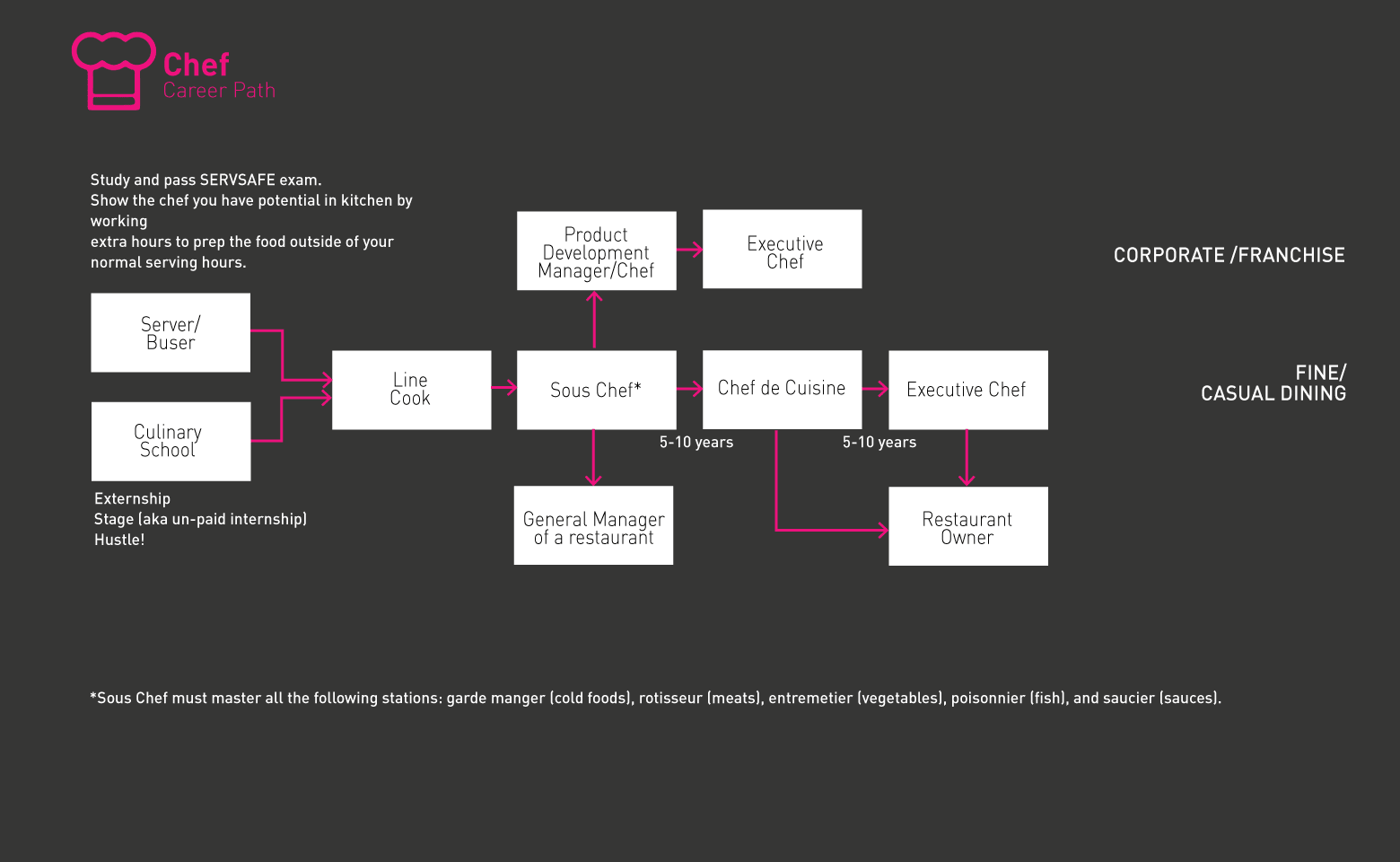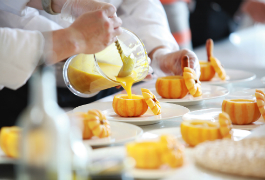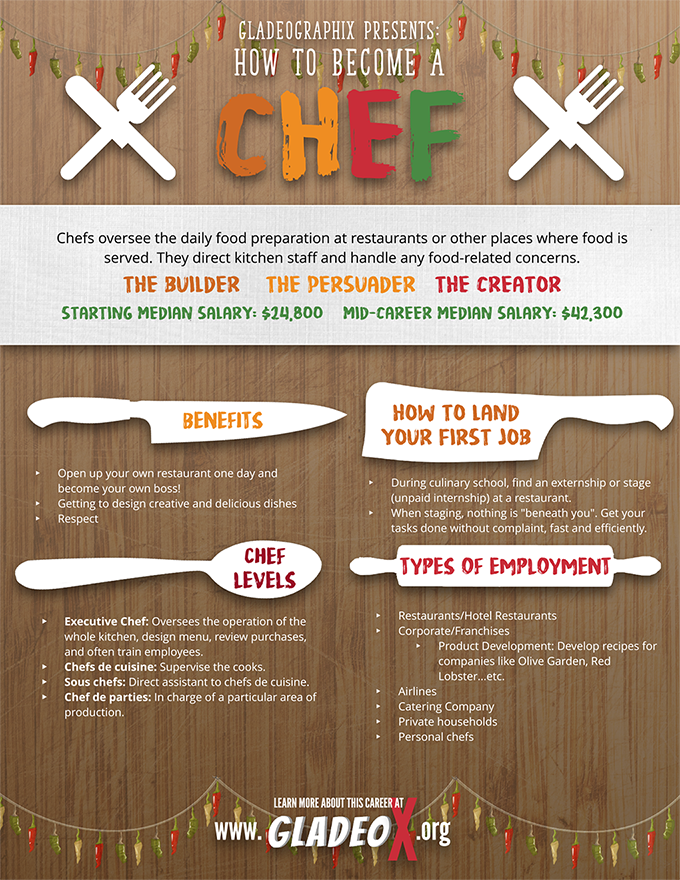Focos
Chef ejecutivo, segundo chef, chef de cocina, chef pastelero, cocinero de línea, especialista culinario, jefe de cocina, chef de banquetes, chef personal, chef corporativo, chef investigador, jefe de cocina, gerente de cocina.
Los chefs supervisan la preparación diaria de los alimentos en restaurantes u otros lugares donde se sirve comida. Dirigen al personal de cocina y se ocupan de cualquier asunto relacionado con la comida.
- ¡Puedes convertirte en tu propio jefe y abrir tu propio restaurante algún día!
- ¡Diseñar platos creativos!
- Respeto
- ¡Preparar platos deliciosos!
Restaurantes/Restaurantes de hotel
- Vida laboral: Trabajo duro, noches y fines de semana, muy competitivo, «glamoroso», con oportunidades de ascenso y, algún día, la oportunidad de crear platos para el menú y tu propio menú.
Empresas/Franquicias
- Trabaja en la sede central de empresas como Olive Garden, Red Lobster, Domino's, etc.
- Desarrollo de productos: Aquí puedes ayudar a desarrollar recetas y a registrar los ingredientes utilizados.
- Vida laboral: horario regular, sin fines de semana, ingresos estables desde el principio, no tan glamuroso y seguro.
- Requisitos: (Dependiendo de la empresa a la que se postule) Algunas empresas exigen unos 10 años de experiencia como chef, ya que es necesario tener experiencia en el coste de los alimentos, cómo reducir los ingredientes para obtener más beneficios, etc.
Compañías aéreas
- Trabajar en el desarrollo de alimentos para sus clientes. Tendrás que ayudar a cocinar pedidos grandes de comida y cumplir con los plazos necesarios para que lleguen al avión.
Empresa de catering
- Trabajar para una empresa que prepara comida para eventos (como bodas).
Hogares privados
- Trabajar para un cliente, como un ejecutivo de empresa, rector universitario o diplomático, que suele ofrecer recepciones como parte de sus funciones oficiales.
Chefs personales
- Planifican y preparan comidas en domicilios particulares. También pueden encargarse de hacer la compra y adquirir los suministros necesarios, servir las comidas y lavar los platos y los utensilios. Los chefs personales suelen trabajar por cuenta propia o estar empleados por una empresa de cocina privada, preparando comida para una gran variedad de clientes.
- Los chefs ejecutivos sonlos principales responsables de supervisar el funcionamiento de toda la cocina. Coordinan el trabajo de los sous chefs y otros cocineros, que preparan la mayor parte de las comidas. Los chefs ejecutivos también tienen muchas otras funciones fuera de la cocina. Diseñan el menú, revisan las compras de alimentos y bebidas y, a menudo, forman a los empleados. Algunos chefs ejecutivos se dedican principalmente a tareas administrativas y pasan poco tiempo en la cocina.
- Los chefs de cocinason los segundos al mando en la cocina. Supervisan a los cocineros del restaurante, realizan algunas tareas de preparación de comidas e informan de los resultados a los jefes de cocina. En ausencia del jefe de cocina, los chefs de cocina se encargan de dirigir la cocina.
- Los sous chefs (pronunciado «su-chef», que en francés significa «subchef») son los asistentes directos de los chefs de cocina. Las cocinas más grandes suelen tener más de un sous chef, cada uno de los cuales cubre un turno determinado o tiene su propia área de responsabilidad, como el sous chef de banquetes, encargado de todos los banquetes, o el sous chef ejecutivo, encargado de todos los demás sous chefs.
- Los chefs de partie (también conocidos como «chefs de estación» o «cocineros de línea») están a cargo de un área concreta de producción. En las cocinas grandes, cada chef de estación puede tener varios cocineros y/o ayudantes. Sin embargo, en la mayoría de las cocinas, el chef de estación es el único trabajador de ese departamento. Los cocineros de línea suelen dividirse en una jerarquía propia, que comienza con el «primer cocinero», seguido del «segundo cocinero», y así sucesivamente según sea necesario.
Las estaciones de chef de partieincluyen:
- Chef de salsas o saucier: prepara salsas, guisos y entremeses calientes, y saltea alimentos por encargo. Suele ser el puesto más alto de todas las estaciones.
- Cocinero de pescado o poissonier: prepara platos de pescado (en algunas cocinas, esta tarea puede recaer en el saucier).
- Cocinero de verduras o entremetier: prepara verduras, sopas, féculas y huevos. Las cocinas grandes pueden dividir estas tareas entre el cocinero de verduras, el cocinero de fritos y el cocinero de sopas.
- Cocinero asador o rotisseur: prepara carnes asadas y estofadas y sus salsas, y asa carnes y otros alimentos a la parrilla según los pedidos. Una cocina grande puede tener un cocinero asador o grillardin (gree-ar-dan) independiente para encargarse de los alimentos asados a la parrilla. El cocinero asador también puede preparar carnes y pescados fritos.
- El chef de despensa o garde manger es responsable de los alimentos fríos, incluyendo ensaladas y aderezos, patés, entremeses fríos y productos para bufé.
- Pastelero o pâtissier: prepara pasteles y postres.
- El cocinero suplente, cocinero suplente o tournant: sustituye a otros jefes de estación.
- Capacidad para trabajar bajo presión.
- Habilidades culinarias (manejo del cuchillo, hervir, saltear, escalfar, estofar y asar a la parrilla)
- Comunicación eficaz
- Gestión del tiempo
- Seguridad y saneamiento
- Capacidad para levantar objetos pesados.
- Liderazgo y gestión (para ascender en la escala jerárquica)
- Arte (presentación de la comida)
- Sector altamente competitivo
- Para restaurantes: No es un trabajo de 9 a 5. ¡Es un estilo de vida! Se trabaja muchas horas, por las noches y los fines de semana.
- Entorno agotador y estresante: estarás siempre de pie y en estado de alerta mientras trabajas.
- ¡Me encantaba cocinar!
- Me encantaba ir a restaurantes y me interesaban la comida y las bebidas.
- Técnicamente, los chefs no necesitan un título universitario; sin embargo, a los empleadores generalmente les gusta ver pruebas de formación reglada.
- O*Net señala que el 52 % de los trabajadores de este campo tienen un título de asociado, el 10 % una licenciatura y el 17 % un certificado.
- Muchos chefs aprenden a través de programas culinarios en universidades comunitarias o escuelas vocacionales, donde obtienen un certificado o un título de asociado. Algunos aprenden el oficio a través de aprendizajes o simplemente son ascendidos desde puestos de cocineros de línea después de unos años de experiencia laboral.
- Los estudiantes de cocina deben esperar aprender no solo habilidades culinarias, sino también protocolos generales de cocina, incluyendo higiene. Otros temas incluyen la planificación de menús y la adquisición de ingredientes e inventario.
- Muchos estados exigen que los chefs obtengan un certificado de gestor de protección alimentaria de la Conferencia para la Protección Alimentaria o una tarjeta de manipulador de alimentos de un programa acreditado por el Instituto Nacional Estadounidense de Normalización.
- Otras opciones de certificación incluyen:
- Asociación Americana de Servicios Alimentarios Penitenciarios - Profesional Certificado en Servicios Alimentarios Penitenciarios
- Federación Culinaria Americana -
- Chef de cocina certificado
- Administrador culinario certificado
- Chef maestro certificado
- Maestro pastelero certificado
- Educador culinario certificado de secundaria
- Sous chef certificado
- Pastelero certificado en activo
- Chef ejecutivo certificado personal
- Asociación Internacional de Ejecutivos de Servicios Alimentarios - Ejecutivo Certificado Maestro en Alimentación
- Asociación Norteamericana de Fabricantes de Equipos para la Industria Alimentaria - Profesional Certificado en Servicios de Alimentación
- Panaderos Minoristas de América - Decorador Certificado
- Asociación de Chefs Personales de Estados Unidos - Chef personal certificado
- Instituto de Planificación de Bodas - Planificador certificado de bodas y eventos
- Cursos de salud y seguridad
- Historia de la cocina
- Después de unos tres meses en el aula, ¡es cuando empieza la diversión!
- Técnicas básicas de corte y picado, salsas básicas,
- Aprende sobre presentación, sabor y temperatura.
- Practicará con diversos platos para ayudar al alumno a aprender sobre el uso rentable de los productos, ideas de presentación y gestión del tiempo. Así es como se le calificará.
- Cocina en casa y toma clases de cocina en la escuela secundaria. No tengas miedo de experimentar con tu propio estilo único.
- Piensa si prefieres cocinar u hornear. Si te gusta cocinar, decide si hay algún tipo de cocina en particular en la que quieras especializarte, como la italiana, la mediterránea, la de Oriente Medio, etc.
- ¡Pide a tus amigos y familiares que prueben tus creaciones! Acepta los comentarios con elegancia.
- Aprende a seguir libros de cocina y sitios web de recetas. Suscríbete a revistas culinarias y mira programas relacionados con la comida en la televisión o YouTube.
- ¡Descubre el amplio mundo de las especias! Intenta crear una buena colección de especias y condimentos esenciales y de buena calidad.
- Prueba diferentes tipos de aceites de cocina, condimentos, guarniciones y acompañamientos para combinar con los platos principales.
- Estudia fotos y consejos sobre presentación de alimentos. Captura imágenes de tus mejores platos para utilizarlas en tu portafolio online.
- Además de fotos, el portafolio de tu chef debe contener recetas, menús de muestra, reseñas, premios, logros académicos y una breve página biográfica «Acerca de mí» con información de contacto.
- Familiarízate con los distintos tipos de utensilios de cocina, elementos calefactores y otros equipos.
- Estudia los ingredientes y su procedencia. Muchos chefs se centran en utilizar ingredientes de origen local, de comercio justo y/o producidos de forma sostenible. Estas prácticas suelen resultar atractivas para los clientes de los restaurantes.
- Si no quieres obtener una licenciatura, prueba a matricularte en un programa de cocina en un centro de formación profesional o una escuela vocacional local.
- Si te lo tomas en serio y quieres convertirte en un chef de primer nivel, plantéate solicitar plaza en uno de los mejores institutos de formación culinaria del mundo, como la Escuela de Artes Culinarias Auguste Escoffier (en Colorado y Texas), la Academia de Artes Culinarias (Suiza) o Le Cordon Bleu (Francia).
- Si la formación internacional no es lo tuyo, echa un vistazo a las 19 mejores escuelas de cocina de Estados Unidos.
- Concierta una entrevista informativa con un chef en activo para preguntarle sobre su trayectoria profesional.
- Busca un trabajo a tiempo parcial como cocinero de línea para ganar experiencia mientras cobras un sueldo (y desarrollas la resistencia necesaria para trabajar de pie durante largas horas en condiciones frenéticas).
- Solicita prácticas culinarias. Llega con suficiente antelación para empezar con los preparativos, mantén una actitud positiva independientemente de las tareas que te asignen e intenta trabajar con rapidez sin descuidar la calidad y la seguridad en ningún momento.
- Si no consigues un trabajo a través de tus prácticas externas, solicita realizar unas prácticas no remuneradas en un restaurante en el que te gustaría trabajar.
- Prepárate para aceptar unas prácticas externas de cocina, que son más cortas e intensas que unas prácticas profesionales.
- Intenta tomar tantas fotos como puedas de los platos que cocines. ¡Esa será tu carpeta de trabajos! Cuando empieces a solicitar empleo tras terminar la escuela de cocina, querrás enviar a los chefs una muestra de lo que eres capaz de hacer. Utiliza Tumblr o algún otro recurso de Internet para mantener organizada toda tu carpeta de trabajos culinarios. Lo más probable es que los chefs hayan visto miles de fotos de comida, por lo que querrán ver organización y presentación.
- Mientras asistes a la escuela de cocina, busca un trabajo a tiempo parcial en el que puedas poner en práctica las habilidades que estás aprendiendo en la escuela.
- Hacia el final de la escuela culinaria, algunas escuelas te ofrecerán unas «prácticas externas», lo que significa que tendrás la oportunidad de realizar prácticas en una empresa relacionada con la alimentación. ¡Trabaja duro y no te quejes!

- Si no consigues un trabajo a través de tus prácticas externas, solicita realizar unas prácticas no remuneradas en un restaurante en el que te gustaría trabajar.
- Durante la entrevista, escucha atentamente lo que te pregunte el chef ejecutivo. Explícale por qué respetas el restaurante. Asegúrate de visitar el restaurante al que vas a solicitar empleo y conocer su menú. ¿Por qué? Porque debes probar todo lo que cocinas.
- Cuando realice la puesta en escena, debe seguir estas reglas:
- Ven temprano y empieza a prepararte.
- No te quejes.
- Nada está «por debajo» de ti: si tu chef te pide que picas 22 kg de ajo, hazlo rápido y con buena actitud.
- Date prisa y termina tus tareas, y avisa al chef para que te asigne algo nuevo que hacer. Debes demostrarle al chef que puedes terminar muchas cosas a la vez en poco tiempo, ya que los chefs de mayor rango deben gestionar varias cosas a la vez.
Sitios web
- Asociación Estadounidense de Servicios Alimentarios Penitenciarios
- Federación Culinaria Americana
- Instituto Nacional Estadounidense de Normalización
- Asociación Americana de Chefs Personales y Privados
- Cadena de los Rotisseurs
- Conferencia sobre protección alimentaria
- Asociación Internacional de Ejecutivos de Servicios Alimentarios
- Fundación James Beard
- Asociación Nacional de Catering y Eventos
- Asociación Nacional de Restaurantes
- Asociación Norteamericana de Fabricantes de Equipos Alimentarios
- Panaderos Minoristas de América
- Asociación de Chefs Personales de Estados Unidos
- Instituto de Planificación de Bodas
- Asociación Mundial de Sociedades de Cocineros
Libros
- Cómo convertirse en chef: la guía esencial para convertirse en chef y desarrollar una carrera culinaria exitosa, por Brandon Fiore.
- El libro de cocina de la escuela de cocina America's Test Kitchen: Todo lo que necesitas saber para convertirte en un gran cocinero, por America's Test Kitchen.
- El chef profesional, por el Instituto Culinario de América
Carreras alternativas: nutricionista, gerente general de un restaurante, desarrollo de productos (empresa alimentaria), crítico gastronómico.
Fuente de noticias

Empleos destacados

Cursos y herramientas en línea

Expectativas salariales anuales
Los nuevos trabajadores comienzan con un salario de alrededor de 59 000 dólares. El salario medio es de 76 000 dólares al año. Los trabajadores con mucha experiencia pueden ganar alrededor de 95 000 dólares.
Expectativas salariales anuales
Los nuevos trabajadores comienzan con un salario de alrededor de 50 000 dólares. El salario medio es de 63 000 dólares al año. Los trabajadores con mucha experiencia pueden ganar alrededor de 84 000 dólares.
Expectativas salariales anuales
Los nuevos trabajadores comienzan con un salario de alrededor de 48 000 dólares. El salario medio es de 58 000 dólares al año. Los trabajadores con mucha experiencia pueden ganar alrededor de 75 000 dólares.
Expectativas salariales anuales
Los nuevos trabajadores comienzan con un salario de alrededor de 52 000 dólares. El salario medio es de 61 000 dólares al año. Los trabajadores con mucha experiencia pueden ganar alrededor de 79 000 dólares.
Expectativas salariales anuales
Los nuevos trabajadores comienzan con un salario de alrededor de 55 000 dólares. El salario medio es de 63 000 dólares al año. Los trabajadores con mucha experiencia pueden ganar alrededor de 82 000 dólares.








